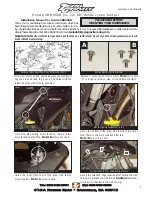
65
Maintenance
Brake Systems
Brake Fluid Precautions
Using the wrong fluid or allowing air or contaminants into the fluid system can damage the system
seals or result in a malfunction that could lead to serious injury or death. Use only DOT 4 brake fluid
from a sealed container.
Do not operate the front brake with the reservoir cover removed. Fluid could overflow from the reservoir
and allow air to enter the system. Air in the brake system could cause the brakes to malfunction.
An over-full reservoir may cause brake drag or brake lock-up, which could result in serious injury or
death. Maintain brake fluid at the recommended level. Do not overfill.
NOTICE:
Brake fluid will damage painted surfaces and plastic parts. Always clean spilled brake fluid
immediately with water and a mild detergent.
Rear Brake Fluid
Change the brake fluid at the intervals recommended in the periodic maintenance table
beginning on page 54. Always add brake fluid from a new, unopened container. Always use
the recommended fluid. See page 104.
1. Position the motorcycle on level ground in the fully upright position.
2. The rear brake fluid reservoir is located near the rear brake pedal. View the reservoir
from the right side of the vehicle.
3. Wipe the fluid container and the area around the reservoir cover with a clean cloth.
4. If the fluid level is low, inspect brake pads
as outlined on page 67. If pads are not
worn beyond the service limit, inspect the
brake system for leaks.
5. Remove the cover and diaphragm. The
fluid level should be above the minimum
indicator mark on the reservoir body. Add
brake fluid as needed.
Do not overfill.
6. Reinstall the cover and diaphragm.
Tighten the cover screws.
Torque:
13 in-lbs (1.5 Nm)
7. Wipe away any fluid spills. Check for
signs of brake fluid leaks around hoses,
fittings, reservoir, and brake calipers.
WARNING
Sight Glass
















































